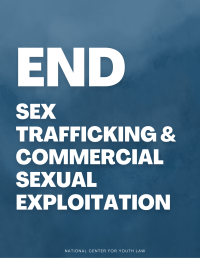L.A. County Marks Progress In Combatting Commercial Sexual Exploitation Of Children
First Responder Protocol leads to recovery of 361 youth
FOR IMMEDIATE RELEASE
November 13, 2018
Contact: Kate Walker Brown, [email protected]
Los Angeles County’s intensive effort to combat the commercial sexual exploitation of children and teens is having a meaningful impact, with 361 young people recovered since the launch of a new First Responder Protocol four years ago.
This victim-centered, trauma-informed approach by law enforcement—along with extensive training of county staff and service providers, the creation of two dedicated courtrooms, and the formation of specialized units within the probation and child welfare agencies—has transformed Los Angeles County’s approach to treating children and youth who have been commercially sexually exploited.
The First Responder Protocol, which was initiated in 2014, is the first of its kind and has become a national model. Conceived with the support of the county agencies, survivors, and the National Center for Youth Law, the protocol defines key steps for law enforcement, county agencies and community-based partners to take within the first 72 hours after they come into contact with a suspected victim of commercial sexual exploitation.
A report on the protocol’s first four years of implementation was presented to the Board of Supervisors today.
“Several years ago, the Board learned that Los Angeles County had become a major hub for the commercial exploitation of children,” said Supervisor Sheila Kuehl, Chair of the Board of Supervisors. “Traffickers were preying on children and forcing them to sell their bodies for money. We took action and I’m proud that this progress report demonstrates L.A. County’s success and national leadership in the ongoing fight to end the sexual exploitation of children.”
“The collaborative work between the Integrated Leadership Team, Cal State LA, and the National Center for Youth Law is exemplary, and demonstrates the success we can achieve tackling tough issues when we work together,” said Supervisor Hilda L. Solis. “As we concentrate our efforts across the County, I am pleased to see greater efforts to hold exploiters and buyers accountable, especially in communities such as Pomona. Law enforcement, coupled with education programs for the community, such as the Parent Empowerment Program, will help address CSEC from every angle and end it once and for all in L.A. County.”
“The First Responder Protocol has made an undeniable difference in the lives of many exploited and abused young people,” Supervisor Mark Ridley-Thomas said. “While it is disheartening to learn of their history of trauma and maltreatment, it reminds us that there are many opportunities during a child's life for any one of us to report abuse, provide support, and intervene to prevent a child from being sex trafficked.”
“For too many children, the trauma of sexual exploitation is followed by the trauma of incarceration,” said Supervisor Janice Hahn. “I’m proud that L.A. County is putting an end to this vicious cycle by standing up for sexually exploited youth and recognizing once and for all that they are the victims, not the perpetrators. As caring and responsible adults, it’s our job to protect our children and put an end to child sex trafficking in L.A. County.”
“The County’s Integrated Leadership Team continues to make remarkable progress in addressing the scourge of child sexual exploitation by providing comprehensive service programs and meaningful solutions,” Supervisor Kathryn Barger said.
Given the physical and mental trauma experienced by youth, the First Responder Protocol focuses on meeting the immediate needs of the youth and supporting them to achieve long-term safety and stability through intensive wrap-around services, including a community-based advocate and a team of other professionals who remain in the youth’s life for a minimum of 90 days, but often for as long as a year.
The collaborative effort has yielded valuable insights into the profile of young people vulnerable to sexual exploitation in Los Angeles County and the impact of the services provided, including:
- Of the 361 youth identified, the average age at first recovery was just under 16 years old, and the youngest victim was an eleven-year-old.
- The youth identified through the protocol were disproportionately African American (71%) and 85% had prior referrals to the child welfare agency.
- The immediate wrap-around services resulted in a significant drop in the number of youth who ran away once they were recovered. With continued support and engagement, only 12% disappeared after the first 72 hours, as of August 14, 2018.
- 5% of youth received a medical evaluation in the first 72 hours after being recovered.
The protocol was piloted in areas served by the Los Angeles County Sheriff’s Department Compton and Century stations, and by the Long Beach Police Department. As of July 2018, the protocol was fully implemented at all Sheriff stations and at all divisions of the Los Angeles Police Department.
These efforts are a collaboration among Probation, Children and Family Services, Sheriff, Health Services and community partners such as the Los Angeles and Long Beach Police Departments—all working together to ensure that Los Angeles County remains a transformative leader in how the country serves youth and families who have been affected by commercial sexual exploitation.
To read the full report, click here.
###





